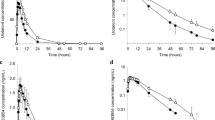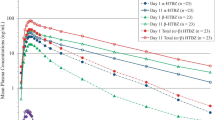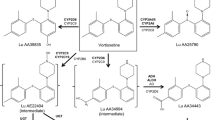Summary
Nine extensive metabolizers (EMs) and eight poor metabolizers (PMs) of sparteine took a single oral dose of 100 mg of desipramine HCI before and while taking paroxetine 20 mg per day.
Before paroxetine, the median of the total desipramine clearance was 7 times higher in EMs than in PMs (102 and 15 l·h−1 respectively). This confirms that desipramine is extensively metabolized via the sparteine/debrisoquine oxidation polymorphism i.e. by CYP2D6. During paroxetine, the median clearances were 22 l·h−1 and 18 l·h−1 in EMs and PMs respectively. The 5-fold decrease in clearance in EMs when desipramine was co-administered with paroxetine confirms that paroxetine is a potent inhibitor of CYP2D6. The lack of effect on clearance in PMs shows that paroxetine is a selective inhibitor of CYP2D6, which is absent from the livers of PMs. Before paroxetine, the median of desipramine clearance via 2-hydroxylation was 40-times higher in EMs than in PMs (56 and 1.4 l·h−1 respectively), but during paroxetine, it was only 2-times higher (6 and 2.9 l·h−1 respectively). The increase in this clearance in PMs suggests that paroxetine is an inducer of the alternative, unidentified P 450(s) which catalyze(s) the formation of 2-OH-desipramine in this phenotype.
Before paroxetine, the median amounts of 2-OH-desipramine glucuronide recovered in urine were 69% and 68% of the total recovery of 2-OH-desipramine in urine in EMs and PMs respectively. During paroxetine, the corresponding values were 77% and 84%. This increase in the relative recovery of the glucuronide was statistically significant in both phenotypes, suggesting that paroxetine is a weak inducer of the glucuronidation of 2-OH-desipramine.
Similar content being viewed by others
References
Johnson AM (1989) An overview of the animal pharmacology of paroxetine. Acta Psychiatr Scand 80 [Suppl 350]: 14–20
Sindrup SH, Gram LF, Brøsen K, Eshøj O, Mogensen EF (1990) The selective serotonin reuptake inhibitor paroxetine is effective in the treatment of diabetic neuropathy symptoms. Pain 42: 135–144
Sindrup SH, Brøsen K, Gram LF, Hallas J, Skjelbo E, Allen A, Allen GD, Cooper SM, Mellows G, Tasker TC, Zussmann BD (1992) The relationship between paroxetine and the sparteine oxidation polymorphism. Clin Pharmacol Ther 51: 278–287
Sindrup SH, Brøsen K, Gram LF (1992) Pharmacokinetics of the selective serotonin reuptake inhibitor paroxetine. Non-linearity and relation to the sparteine oxidation polymorphism. Clin Pharmacol Ther 51: 288–295
Brøsen K, Gram LF, Kragh-Sørensen P (1991) Extremely slow metabolism of amitriptyline but normal metabolism of imipramine and desipramine in an extensive metabolizer of sparteine, debrisoquine, and mephenytoin. Ther Drug Monit 13: 177–182
Crewe HK, Lennard MS, Tucker GT, Woods FR, Haddock RE (1992) The effect of selective serotonin reuptake inhibitors on cytochrome P4502D6 (CYP2D6) activity in human liver microsomes. Br J Clin Pharmacol 34: 262–265
Skjelbo E, Brøsen K (1992) Inhibitors of imipramine metabolism by human liver microsomes. Br J Clin Pharmacol 34: 265–261
Brøsen K, Gram LF (1989) Clinical significance of the sparteine/debrisoquine oxidation polymorphism. Eur J Clin Pharmacol 36: 537–547
Eichelbaum M, Gross AS (1990) The genetic polymorphism of debrisoquine/sparteine metabolism — clinical aspects. Pharmacol Ther 46: 377–394
Kagimoto M, Heim M, Kagimoto K, Zeugin T, Meyer UA (1990) Multiple mutations of the human cytochrome P450IID6 gene (CYP2D6) in poor metabolizers of debrisoquine. J Biol Chem 265: 17209–17214
Zanger UM, Vilbois F, Hardwick JP, Meyer UA (1988) Absence of hepatic cytochrome P450bufl causes genetically deficient debrisoquine oxidation in man. Biochemistry 27: 5447–5454
Alván G, Bechtel P, Iselius L, Gundert-Remy U (1990) Hydroxylation polymorphisms of debrisoquine and mephenytoin in European populations. Eur J Clin Pharmacol 39: 533–537
Bertilsson L, Aaberg-Wistedt A (1983) The debrisoquin hydroxylation test predicts steady-state plasma levels of desipramine. Br J Clin Pharmacol 15: 388–390
Brøsen K, Otton SV, Gram LF (1986) Imipramine demethylation and hydroxylation: impact of the sparteine oxidation phenotype. Clin Pharmacol Ther 40: 543–549
Brøsen K, Klysner R, Gram LF, Otton SV, Bech P, Bertilsson L (1986) Steady-state concentrations of imipramine and its metabolites in relation to the sparteine/debrisoquine polymorphism. Eur J Clin Pharmacol 30: 679–684
Hirschowitz J, Bennett JA, Zemlan FP, Garver DL (1983) Thioridazine effect on desipramine plasma levels. J Clin Psychopharmacol 3: 376–379
Gram LF (1975) Effects of perphenazine on imipramine metabolism in man. Psychopharmacol Comm 1: 165–175
Steiner E, Dumont E, Spina E, Dahlquvist R (1987) Inhibition of desipramine 2-hydroxylation by quinidine and quinine. Clin Pharmacol Ther 43: 577–581
Bell IR, Cole JO (1988) Fluoxetine induces elevation of desipramine level and exacerbation of geriatric non-psychotic depression. J Clin Psychopharmacol 8: 447–448
Vinks A, Inaba T, Otton SV, Kalow K (1982) Sparteine metabolism in Canadian Caucasians. Clin Pharmacol Ther 31: 23–29
Sanz EJ, Villén T, Alm C, Bertilsson L (1989) S-mephenytoin hydroxylation phenotypes in a Swedish population determined after coadministration with debrisoquin. Clin Pharmacol Ther 45: 495–499
Gram LF, Bjerre M, Kragh-Sørensen P, Kvinesdal B, Molin J, Pedersen OL, Reisby N (1983) Imipramine metabolites in blood of patients during therapy and after overdose. Clin Pharmacol Ther 33: 335–342
Gram LF (1974) Metabolism of tricyclic antidepressants. Dan Med Bull 21: 218–231
Kramer Nielsen K, Brøsen K (1993) High-performance liquid chromatography of imipramine and six metabolites in human plasma and urine. J Chromatogr 612: 87–94
Allen GD (1990) MODFIT. A pharmacokinetic computer program. Biopharm Drug Disp 11: 477–498
Wulff HR, Schlichting P (1988) MEDSTAT version 2.1. The Astra Group A/S, Albertslund
Brøsen K, Gram LF (1989) Quinidine inhibits the 2-hydroxylation of imipramine and desipramine but not the demethylation of imipramine. Eur J Clin Pharmacol 37: 155–160
Bloomer JC, Woods FR, Haddock RE, Lennard MS, Tucker GT (1992) The role of cytochrome P4502D6 in the metabolism of paroxetine by human liver microsomes. Br J Clin Pharmacol 33: 521–523
Brøsen K, Zeugin T, Meyer UA (1991) Role of P450IID6, the target of the sparteine/debrisoquin oxidation polymorphism, in the metabolism of imipramine. Clin Pharmacol Ther 49: 609–617
Okey A (1990) Enzyme induction in the cytochrome P450 system. Pharmacol Ther 45: 241–298
Romiti P, Giuliani L, Pacifici GM (1992) Interindividual variability in the N-sulphation of desipramine in human liver and platelets. Br J Clin Pharmacol 33: 17–23
Brøsen K, Skjelbo E (1991) Fluoxetine and norfluoxetine are potent inhibitors of P450IID6 — the source of the sparteine/debrisoquine oxidation polymorphism. Br J Clin Pharmacol 32: 136–137
Bergstrom RF, Peyton AL, Lemberger L (1992) Quantification and mechanism of the fluoxetine and tricyclic antidepressant interaction. Clin Pharmacol Ther 51: 239–248
Otton SV (1984) In vitro oxidation of sparteine by human liver. PhD thesis, Department of Pharmacology, University of Toronto
Gram LF, Hansen MGJ, Sindrup SH, Brøsen K, Poulsen JH, Aaes-Jørgensen T, Overø KF (1993) Citalopram: interaction studies with levomepromazine, imipramine and lithium. Ther Drug Monit 15: 18–24
Spina E, Gampo GM, Avenoso A, Pollicino MA, Caputi AP (1992) Interaction between fluvoxamine and imipramine/desipramine in four patients. Ther Drug Monit 14: 194–196
Author information
Authors and Affiliations
Rights and permissions
About this article
Cite this article
Brøsen, K., Hansen, J.G., Nielsen, K.K. et al. Inhibition by paroxetine of desipramine metabolism in extensive but not in poor metabolizers of sparteine. Eur J Clin Pharmacol 44, 349–355 (1993). https://doi.org/10.1007/BF00316471
Received:
Accepted:
Issue Date:
DOI: https://doi.org/10.1007/BF00316471




